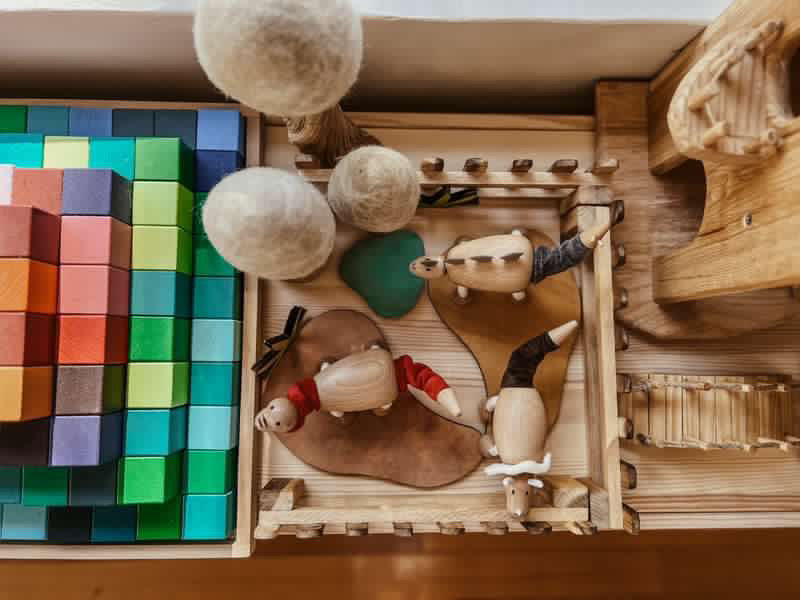The evolution of wooden toys

Wooden toys have been enjoyed by children for centuries. They are not only entertaining but also educational, helping children develop their creativity, imagination, and motor skills. From the earliest times, people have made toys out of wood, and the evolution of wooden toys has been closely linked to the development of society and culture. In this blog, we will explore the history and evolution of wooden toys, from ancient times to the modern era.
Ancient Times: Wooden Toys as Symbols of Wealth and Status
Wooden toys have been found in ancient Egyptian tombs and were often used as offerings to the gods. The ancient Greeks also made wooden toys, such as spinning tops and yo-yos, which were used for both play and as educational tools. In ancient China, wooden toys were made for the children of the aristocracy, with elaborate designs and intricate carving. These toys were seen as symbols of wealth and status.
Middle Ages: Simple Wooden Toys for Entertainment and Amusement
During the Middle Ages, wooden toys became simpler and more accessible to the general population. Simple wooden dolls, horses, and spinning tops were popular toys for children, while wooden board games, such as chess and checkers, were enjoyed by adults. Toy-making became a cottage industry, with craftsmen producing toys for local markets.

Renaissance: The Rise of Artistic Wooden Toys
The Renaissance period saw the rise of artistic wooden toys, with craftsmen using their skills to create elaborate and detailed toys. In Germany, the Erzgebirge region became famous for its wooden toys, including nutcrackers, figurines, and Christmas decorations. Wooden puppets also became popular during this period, with the Italian puppet theatre or "Commedia dell'arte" influencing puppetry across Europe.
Industrial Revolution: Mass Production of Wooden Toys
The Industrial Revolution brought about significant changes in the production of wooden toys. Mass production techniques were introduced, which made toys more affordable and accessible to the general population. Wooden blocks and puzzles, trains, and building sets were popular toys during this period. These toys helped children develop their cognitive and problem-solving skills.
20th Century: The Golden Age of Wooden Toys
The 20th century saw the golden age of wooden toys, with many companies producing high-quality, durable toys. In the United States, companies such as Fisher-Price and Playskool produced wooden toys, including pull-along toys, puzzles, and building sets. In Europe, companies such as Brio and Haba produced wooden toys, including trains, dolls, and play kitchens. Wooden toys became a popular alternative to plastic toys, as they were seen as more environmentally friendly and durable.
Modern Era: Wooden Toys in the Digital Age
In the digital age, wooden toys have continued to be popular, with many parents choosing them over plastic toys. Wooden toys are seen as more sustainable and environmentally friendly, and they offer a break from the screen-based devices that dominate modern playtime. Wooden toys are often made from sustainably sourced wood and are designed to last for generations.
In recent years, there has been a resurgence of interest in traditional wooden toys, with many parents and educators recognising their value in promoting creativity, imagination, and problem-solving skills. Wooden blocks, building sets, and puzzles are popular toys for young children, while wooden board games and puzzles are enjoyed by adults.
Conclusion: The Enduring Appeal of Wooden Toys
Wooden toys have been enjoyed by children for centuries, and their enduring appeal lies in their simplicity, durability, and educational value. From ancient times to the modern era, wooden toys have evolved with society and culture, reflecting the changing needs and values of each era. Today, wooden toys continue to be a popular alternative to plastic toys, offering children a break from screen-based devices and encouraging them to use their imagination and creativity.
Anamalz are designed for interactive and educational play. Winner of over 15+ industry awards including an Australian International Design Award, they are made from plantation beech wood, rope and fabric. Anamalz meet all international manufacturing standards for ages 3+. Best of all, Anamalz come with a life-time guarantee.



Share and get 15% off!
Simply share this product on one of the following social networks and you will unlock 15% off!